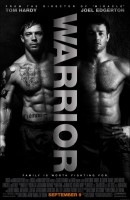Taglines: Family is worth fighting for.
An ex-Marine haunted by a tragic past, Tommy Riordan returns to his hometown of Pittsburgh and enlists his father, a recovered alcoholic and his former coach, to train him for an MMA tournament awarding the biggest purse in the history of the sport. As Tommy blazes a violent path towards the title prize, his brother, Brendan, a former MMA fighter unable to make ends meet as a public school teacher, returns to the amateur ring to provide for his family.
Even though years have passed, recriminations and past betrayals keep Brendan bitterly estranged from both Tommy and his father. But when Brendan’s unlikely rise as an underdog sets him on a collision course with Tommy, the two brothers must finally confront the forces that tore them apart, all the while waging the most intense, winner-takes-all battle of their lives.
About the Production
That is the central question of director Gavin O’Connor’s WARRIOR. The movie is an intense glimpse into the world of a sport never before shown like this on film. More than that though, it’s an intense glimpse into a family’s journey from brokenness to reparation, and into the hearts of two brothers – one fighting for his country, the other for his family – both tapping into immense stores of vigor and courage.
WARRIOR thrives on the juxtaposition of its portrayal of something as contemporary, infectious, and specific as the phenomenon that is mixed martial arts with a story that is thoroughly classic, a story of family. In fact, mano-a-mano chronicles of estranged brothers confronting one another are one of the oldest themes in literature, and telling one in such a fresh setting was O’Connor’s primary inspiration for making the film. While the movie was indeed an opportunity for him to realistically dramatize a not-yet-mainstream sport with a major mystique, the story is really for and about “people who live warrior lives,” – everyday heroes fighting everyman fights for better opportunities and better relationships.
The start of the film finds Tommy Conlon (Tom Hardy) back in the orbit of a broken family he’d given up on years ago. When he and his mother escaped his abusive father Paddy (Nick Nolte), his brother Brendan (Joel Edgerton) stayed behind to be close to his high school girlfriend Tess (Jennifer Morrison), to whom he is now married.
Though Paddy and Tommy have made a patchy truce in order to train together once again, communication between the brothers is nonexistent when they both make a surprise ascent up the rungs of the nationally televised Sparta tournament. The matches, explains O’Connor, are the backdrop to “a story about two brothers on a collision course who have to deal with their past in the present day, in a cage, communicating with their fists to rectify a very painful situation.”
Although by facing off the brothers are ultimately able to break through many years of pent up hostility and regret, each has more than their fraternal relationship at stake in the tournament. Each really needs to win the giant cash prize, though for very different reasons. Brendan’s family has been hit hard by the economic crisis and he and Tess are in deep debt on their modest house.
Having exhausted all other avenues, Brendan, a longtime high school teacher, reluctantly revisits his distant past and begins moonlighting in small local underground fights, hoping to win enough money to stay in the house for another month while they can figure out a viable solution. When his fighting gets him suspended from his teaching job, a comeback that began in parking lots out of desperation for quick extra cash morphs into a personal crusade: to be taken seriously as a fighter despite his age and long absence from the sport, and to push himself as far as he can possibly go.
Tommy, on the other hand, is a lone wolf. He joined the Marine Corps after his mother’s death and has been drifting and falling into trouble since he returned from Iraq. When we first meet him, Tommy’s past is a mystery and his motives are inscrutable. But as the story unfolds, we learn he made a promise to a fallen comrade to take care of his family in the event of his death. Now, he is fighting for the money to fulfill that promise. Should he win the $5 million grand prize at Sparta, he has pledged to give it all to the now single mother and small children his former friend left behind.
Balancing the audience’s sympathies and alliances between the brothers was one of the biggest challenges inherent in the filmmaking. With both of them fighting for something so important, as O’Connor puts it, “you’re rooting for Tommy to keep winning, and you’re rooting for Brendan to keep winning.” But then, the audience is faced with a decision: who they root for when the brothers finally face each other. In O’Connor’s mind, despite Tommy’s noble motives for entering the tournament, the trick to the movie is that the audience has to be ready to see Tommy lose, which for him is also actually to win. He elaborates, “Tommy’s win is losing, because he’s so spiritually bankrupt. He needs to die at the hands of his brother to be reborn. It’s very Old Testament storytelling in the most contemporary way.”
In many ways, the project was a second-nature stop on O’Connor’s filmmaking trajectory. Many of his colleagues on the film see WARRIOR as sitting firmly at the intersection of the sentiments and stories at the heart of his previous films “Miracle” and “Pride and Glory.” “Gavin brought an energy and a populist quality to ‘Miracle’ that had you standing on your feet cheering at the end of the movie, despite the fact that you knew exactly what was going to happen,” explains producer Greg O’Connor. “He’s an All-American college linebacker. He understands camaraderie, how sports work. ‘Pride and Glory’ was sort of an evolution of Gavin’s style – a very intense, muscular cop movie, a hard ‘R’ where ‘Miracle’ was meant for a broad audience.” Greg O’Connor points out that WARRIOR combines the best of both of these films. “We get the investment in the sport and the on-your-feet cheering response from ‘Miracle,’ but also the drama – the story of a father-son relationship getting torn apart and put back together again –, with some of the grit of ‘Pride and Glory.’ That makes this the perfect movie for Gavin.”
Another thing that made this film the perfect fit for O’Connor was his credibility in the fight world, after having produced the acclaimed 2003 HBO documentary “The Smashing Machine: The Life and Times of Mark Kerr,” which took a hard look at the life of MMA fighter Kerr in and out of the ring, as he battled his own demons and attempted to hold his personal life together while traveling the world as a mixed martial arts professional. The film was noted especially for presenting Kerr as an intelligent man who made a calculated decision to pursue a career in a physically dangerous sport.
The honest portrayal is what resonated with so many in the professional fight community, which led to their support of O’Connor’s desire to make a fictional film set in their world. Says JJ Perry, the film’s stunt coordinator and fight choreographer, “’Smashing Machine’ is my favorite documentary of all time. It really captures what MMA is, and it came out before the sport was popular. I knew immediately that if WARRIOR was in the same hands, it was with someone who understood and would do justice to what we love as stuntmen, martial artists and fighters. That’s what really got us here.”
Warrior
Directed by: Gavin O’Connor
Starring: Jennifer Morrison, Tom Hardy, Nick Nolte, Bryan Callen, Joel Edgerton, Vanessa Martinez, Kevin Dunn, Jake McLaughlin
Screenplay by: Gavin O’Connor, Anthony Tambakis, Cliff Dorfman
Production Design by: Dan Leigh
Cinematography by: Masanobu Takayanagi
Film Editing by: Sean Albertson, Matt Chesse, John Gilroy, Aaron Marshall
Costume Design by: Abigail Murray
Set Decoration by: Ron von Blomberg
Art Direction by: James Donahue
Music by: Mark Isham
MPAA Rating: PG-13 for sequences of intense mixed martial arts fighting, some language and thematic material.
Studio: Lionsgate Films
Release Date: September 9, 2011
Hits: 129





